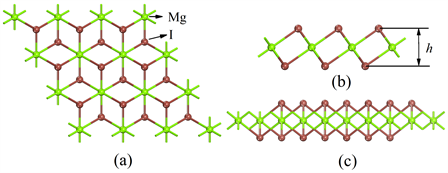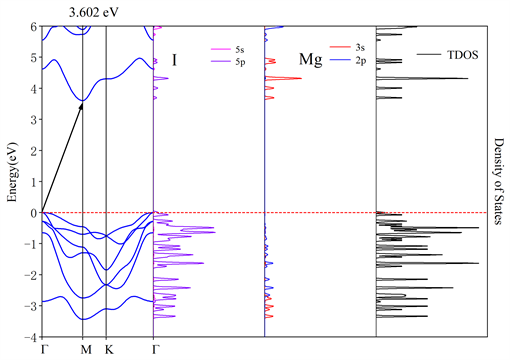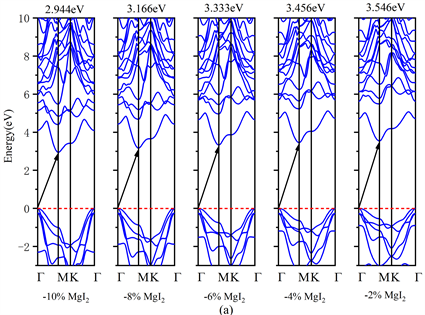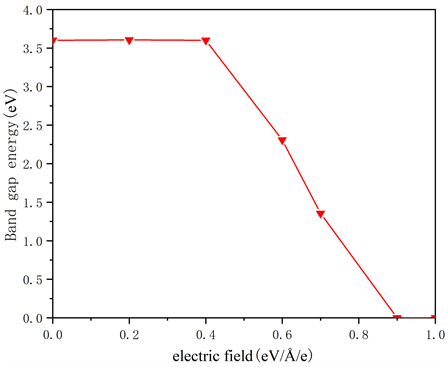Modern Physics
Vol.
11
No.
05
(
2021
), Article ID:
45697
,
10
pages
10.12677/MP.2021.115013
双轴应变和外部电场对单层MgI2电子 结构的调控
钱胜辉,高佳喜,刘光华*
天津工业大学,物理科学与技术学院,天津
收稿日期:2021年8月27日;录用日期:2021年10月6日;发布日期:2021年10月13日

摘要
本文采用基于密度泛函理论的第一性原理方法,研究了施加双轴应变及外电场对单层MgI2电子结构的影响,并分析了能带图、态密度图等。计算结果表明:纯净体系的单层MgI2是一个间接半导体,能隙值为3.602 eV。声子谱没有虚频表明其结构可以稳定存在。随着双轴应变值从−10%到10%,单层MgI2能隙值从2.944 eV变化到3.406 eV。有趣的是,在应变值−10%到4%下,能隙值一直在增加,在4%到10%范围内,能隙值在减小,并且在4%这个应变值下获得最大能隙值3.673 eV。将外部电场设置为0 eV/Å/e至1 eV/Å/e,发现单层MgI2在0.2 eV/Å/e到0.4 eV/Å/e电场下能隙值与纯净体系能隙值相差不大,在0.6 eV/Å/e至0.7 eV/Å/e半导体类型由间接能隙半导体变为直接能隙半导体,0.9 eV/Å/e到1.0 eV/Å/e变为金属,因此判定在0.7 eV/Å/e到0.9 eV/Å/e之间发生了半导体到金属的相变。
关键词
单层MgI2,第一性原理计算,电子结构,双轴应变,外加电场

Tuning the Electronic Structure of Monolayer MgI2 by Biaxial Strain and External Electric Field
Shenghui Qian, Jiaxi Gao, Guanghua Liu*
School of Physical Science and Technology, Tiangong University, Tianjin
Received: Aug. 27th, 2021; accepted: Oct. 6th, 2021; published: Oct. 13th, 2021

ABSTRACT
In this paper, the effects of biaxial strain and external electric field on the electronic structure of monolayer MgI2 are studied by using the first principle method based on density functional theory, and the energy band diagram and density of states diagram are analyzed. The results show that the monolayer MgI2 of the pure system is an indirect semiconductor with a band gap of 3.602 eV. The phonon spectrum has no virtual frequency, indicating that it can exist stably. With the biaxial strain from −10% to 10%, the band gap of monolayer MgI2 changes from 2.944 eV to 3.406 eV. Interestingly, the strain value is −10% to 4%, the energy gap value is increasing, the energy gap value is decreasing in the range of 4% to 10%, and the maximum strain value of 3.673 eV is obtained at the strain value of 4%. When the external electric field is set to 0 eV/Å/e to 1 eV/Å/e, it is found that the band gap value of monolayer MgI2 is almost the same as that of pure system under the electric field of 0.2 eV/Å/e to 0.4 eV/Å/e, and the semiconductor type changes from indirect band gap semiconductor to direct band gap semiconductor under 0.6 eV/Å/eto 0.7 eV/Å/e, from 0.9 eV/Å/e to 1.0 eV/Å/e to metal. Therefore, it is determined that a semiconductor to metal phase transition has occurred between 0.7 eV/Å/e and 0.9 eV/Å/e.
Keywords:Monolayer MgI2, First-Principle Calculations, Electronic Structure, Biaxial Strain, External Electric Field

Copyright © 2021 by author(s) and Hans Publishers Inc.
This work is licensed under the Creative Commons Attribution International License (CC BY 4.0).
http://creativecommons.org/licenses/by/4.0/


1. 引言
自从石墨烯被成功制备出来 [1] ,石墨烯拥有卓越的物理化学性质引起了研究者们极大的兴趣,但石墨烯的零能隙限制了它在光电材料中的应用 [2] [3] 。基于此缺陷,研究者们又把眼光投放到其他二维材料上,发现了例如硅烯 [4] 、六角氮化硼 [5] 、类石墨烯的氧化锌 [6] 、过渡金属硫化物 [7] 等。二维材料由于具有比三维块体材料更优异的物理和化学性能,如大的比表面积、具有原子级别的厚度等,引起了研究者的广泛关注。此外,它还具有优良的光学、电学和热力学性能,因此被广泛应用于自旋电子学、吸附、催化、纳米电子学等领域 [8] [9] [10] 。
最近,Lu等人 [11] 提出了一系列单层金属卤化物MX2 (M = Mg, Ca, Zn, Cd, Ge, Pb; X = Cl, Br, I),引起了研究者的极大兴趣。Chen等人 [12] 研究了双轴应变可调控CaI2单层的电子结构和光学性质,揭示了双轴应变可从−10%到10%调节能隙。此外,发现能隙从−10%逐渐增大到4%,在拉伸应变为4%时达到最大值,然后在应变值为4%到10%时减小。Lima等人 [13] 研究了非金属(NM)和过渡金属(TM)原子掺杂单层MgCl2,发现单层MgCl2的磁矩和能隙可以有效地改变。Hoat等人 [14] 分析了通过施加应变和外加电场来调节二维GeI2的电子结构,研究结果表明二维GeI2属于能隙为2.188 eV的间接半导体。随着双轴应变(XY方向)从12%到−12%的变化,当应变值达到−6%时,2D GeI2的能隙曲线略有增加,但在应变−6%到12%时,能隙曲线缓慢下降。Almayyali等 [15] 研究了碘化锌(ZnI2)在双轴应变(−6%到6%)作用下的电子和光学性质,发现能隙逐渐增加。
对于单层金属卤化物MgI2至今报道还很少,双轴应变及外加电场会带来什么样的物理现象尚不清楚,Lu [11] 表明MgI2是一种能带值为3.67 eV的间接半导体。因此,对于单层MgI2,我们利用基于DFT (density functional theory)的第一性原理方法研究了施加双轴应变及外电场的单层MgI2的电子结构。计算发现施加双轴应变及外部电场可以有效调节的单层MgI2电子结构。我们将双轴应变范围设置为−10%至10%,计算结果表明,在应变范围为−10%至4%时,能隙值逐渐增大,但在双轴应变范围为4%至10%时,能隙值减小。将外部电场设置为0 eV/Å/e至1 eV/Å/e,发现单层MgI2在0.2 eV/Å/e到0.4 eV/Å/e电场下能隙值同纯净体系相差不大,说明能隙值在弱电场下的变化不明显。而在强电场下0.6 eV/Å/e到0.7 eV/Å/e能隙值在逐渐减小以及半导体类型发生了由间接能隙半导体变为直接能隙半导体,最终在0.9 eV/Å/e到1.0 eV/Å/e变化为金属并且产生了磁性,说明单层MgI2在电场0.7 eV/Å/e到0.9 eV/Å/e之间发生了半导体到金属的相变。
2. 计算方法
本文采用基于密度泛函理论的第一性原理方法CASTEP软件计算了电子结构及态密度 [16] [17] 。选择广义梯度近似(GGA)和Perdew-Burke-Ernzerhof (PBE)作为交换关联势 [18] 。为了描述原子核和价电子之间的关系,分别选择2p63s2和5s25p5作为Mg和I的价态。我们选择模守恒赝势。为了避免沿z轴方向的周期层的相互作用,使用了20 的真空层。我们使用Grimme [19] 提出的经验色散校正DFT-D方法来消除弱范德华相互作用。截断能设置为1000 eV,布里渊区取样使用 点Monkhorst-Pack网格 [20] 。所有结构均完全松弛,直至收敛,总能量和力的最小值分别为1 × 10−6 eV和0.01 eV/Å。
应变系数 定义为:
(1)
其中,a和a0分别表示有应变和无应变的晶格参数。双轴应变范围为−10%至10%,设置2%为一个步长点,负值和正值分别代表压缩应变和拉伸应变。对于外加电场来说,设置范围为0 eV/Å/e至1 eV/Å/e,同样设置0.2 eV/Å/e作为一个步长点。
3. 结果与讨论
3.1. 单层MgI2的电子结构和结构稳定性

Figure 1. (a) Top- (b) Front- and (c) Side view of monolayer MgI2
图1. 单层MgI2 (a)俯视图-(b) 正视图-及(c) 侧视图
单层MgI2为六方晶体结构,空间群为P-3M1(No.164)。图1(a)、图1(b)和图1(c)分别显示了单层MgI2的俯视图、正视图和侧视图。从图1(c)可以看出,MgI2具有三个原子层I-Mg-I,每个Mg原子周围有六个I原子,形成八面体配位 [21] 。单层MgI2的优化晶格参数为a = b = 4.17 Å,键长(dMg-I),键角(θMg-I-Mg)和原子层厚度(hI-I)分别为2.939 Å,90.383˚和3.371 Å,与先前的理论值一致 [11] [22] ,这些优化结果表明了我们的参数设置是合理的,计算结果是可靠的。
表1显示了MgI2的键长(dMg-I)、键角(θMg-I-Mg)和原子层厚度(hI-I)随不同双轴应变值变化的结果。双轴应变在−10%到10%之间时,键长(dMg-I)和键角(θMg-I-Mg)逐渐增大,但原子层厚度(hI-I)逐渐减小。为了验证单层MgI2的稳定性,计算了声子谱。发现纯净态单层MgI2 (见图2)的声子色散曲线没有虚频,因此证实了单层MgI2的稳定性。图3显示了本征单层MgI2的能带以及总态密度和分态密度(total and partial density of states, TDOS和PDOS)。从图3可以看出,单层MgI2是一种间接半导体,能带值为3.602 eV,TDOS主要来自价带的I-5p轨道,导带主要来自Mg-3s轨道和I-5p轨道的sp杂化,这与之前的数据一致 [7] 。此外,价带最大值(VBM)和导带最小值(CBM)分别位于Γ和M点。

Figure 2. The phonon dispersion curve of pure monolayer MgI2
图2. 纯净态单层MgI2的声子色散曲线

Figure 3. The energy band gap, total and partial density of states (TDOS and PDOS) of monolayer MgI2
图3. 单层MgI2的能带,总态密度和分态密度图
3.2. 双轴应变下的单层MgI2的电子结构
图4(a)和图4(b)揭示了单层MgI2的能带受双轴应变的影响。计算的能带的高对称点方向选择为 。从图4(a)和图4(b)中,我们观察到在双轴应变下单层MgI2仍然是间接半导体,没有改变半导体的类型。并且在双轴应变值为−10%到10%时,能隙值从2.944 eV变化到3.406 eV。这是因为双轴应变可以有效地改变晶格参数,进而改变布里渊区的大小。当应变值在−10%到4%之间时,价带最大值(valence band maximum, VBM)和导带最小值(conduction band minimum, CBM)仍然分别位于Γ和M点。然而,随着应变范围从6%到10%,价带最大值(VBM)略微偏离Γ点向M点移动。图5显示单层MgI2的能隙值曲线。从图5可以清楚地看出,随着压缩应变的增加,能隙值逐渐增加。而在拉伸应变下,能隙先增大后减小,最大能隙值在双轴应变值为4%的情况下取得,数值为3.673 eV。出现这种现象的原因是双轴应变的施加影响了原子之间的相对位置, 从而影响了原子与原子之间的成键性质和强度, 进而导致能带结构发生改变。通过我们分析态密度(DOS)图发现双轴应变下单层MgI2的价带部分是由Mg-3s和I-5p轨道的sp杂化共同贡献,发现在−10%到10%应变下态密度为零的价带部分所占据的能量值先增大后减小,在4%这个应变值下能量值最大。因此,能隙的变化也是先增大后减小。结果表明,双轴应变下的能隙变化趋势与CaI2相似 [8] 。
Table 1. The Bond Length dMg-I (Å), Bond Angle θMg-I-Mg (˚) and Atomic Layer Thickness (hI-I) (Å) of MgI2 with Biaxial Strain
表1. 双轴应变下MgI2的键长dMg-I (Å),键角θMg-I-Mg (˚)及原子层厚度(hI-I) (Å)


Figure 4. (a) The energy band versus under different compressive strain. (b) The energy band versus under different tensile strain
图4. (a) 压缩应变下的能隙曲线。(b) 拉伸应变下的能隙曲线

Figure 5. The energy band values curve of monolayer MgI2 with different biaxial strain
图5. 不同应变下的单层MgI2的能隙曲线
为了更好地分析能隙的变化,以及解释为什么出现能隙先增大后减小的原因。我们计算了不同双轴应变下单层MgI2的总态密度和分态密度(TDOS和PDOS)。选取的能量范围从−5 eV到5 eV之间,这包括了费米能级附近导带和价带的电子信息分布。从图6中我们可以清楚地发现,随着应变值的增加,价带的扩展能范围变得越来越窄。其中,当应变值为−10%时,总态密度(TDOS)在价带部分的边缘能量值为−4.9 eV;当应变值为10%时,它变化为−2.82 eV。出现能隙先增大后减小的原因是双轴应变的施加影响了原子之间的相对位置,从而影响了原子与原子之间的成键性质和强度,进而导致能带结构发生改变。通过我们分析总态密度(TDOS)图和分态密度(PDOS)发现双轴应变下单层MgI2的价带部分是由Mg-3s和I-5p轨道的sp杂化共同贡献,在−10%到10%应变下态密度为零的价带部分所占据的能量值先增大后减小,在4%这个应变值下能量值最大。因此,相对应能隙的变化也是先增大后减小。

Figure 6. The total and project density of state (TDOS and PDOS) of monolayer MgI2 under biaxial strain
图6. 双轴应变下单层MgI2的总态密度和分态密度图
为了更好地理解在双轴应变下单层MgI2中的内部电荷分布,我们计算了布居数。表2显示Mg和I的总电荷和转移电荷,其中,表2中的Mg total和I total分别表示单层MgI2中Mg原子和I原子拥有的固有电荷数,Mg charge和I charge分别表示转移电荷数。从表2可以清楚地发现Mg原子和I原子分别携带正电荷和负电荷。随着双轴应变从−10%增加到10%,Mg和I的总电荷分别减少和增加,这意味着电荷逐渐从Mg原子转移到I原子。
Table 2. Internal charge distribution (e) of constituent atoms in the MgI2 monolayer under biaxial strain by Mulliken population analysis
表2. 通过Mulliken布居分析研究了双轴应变下MgI2单层中组成原子的内部电荷分布(e)
3.3. 施加外电场对单层MgI2的电子结构调控
接下来我们研究了施加外电场E调控单层MgI2能带结构。施加的电场方向垂直于xy平面,平行于z轴,电场的方向沿着z轴向上。观察到的施加外电场调控单层MgI2的能带结构展示在图7。能隙的变化趋势曲线展示在图8。在0.2 eV/Å/e时能隙值为3.606 eV,施加电场为1.0 eV/Å/e时则变成了金属。从图7和图8中可以观察到在电场为0.2 eV/Å/e至0.4 eV/Å/e时,能隙值变化和纯净单层MgI2能隙值相差不大,说明弱电场对于单层MgI2能带结构的影响不大,单层MgI2仍然是一个间接能隙半导体。当电场施加到0.6 eV/Å/e到0.7 eV/Å/e时,单层MgI2能隙值和半导体类型发生了明显的改变,能隙值突然分别降低到2.309 eV和1.355 eV并且变为直接能隙半导体。证明强电场可以有效缩短单层MgI2的禁带宽度和改变半导体的类型。众所周知,电场效应下的范德瓦尔斯异质结构中的耦合对能带有显著影响会导致发生半导体到金属相变。我们观察到在0.7 eV/Å/e时单层MgI2是一个直接能隙的半导体,在0.9 eV/Å/e时变为了半金属,因此可以推测出在0.7 eV/Å/e至0.9 eV/Å/e之间单层MgI2发生了半导体到金属的相变。发生这个相变的原因是:施加电场能够使半导体发生极化,使正负电荷重心偏离,随着电场强度的不断增加,电极化会越来越剧烈。当电场大到一定程度时,电子可以由束缚态变游离态,最终可以导电变为金属。因此,施加电场可以使单层MgI2发生半导体到金属的相变。并且,0.9 eV/Å/e到1.0 eV/Å/e下的单层MgI2还拥有了铁磁性。

Figure 7. Band structure of MgI2 monolayer applied electric field
图7. 施加电场下的单层MgI2的能带结构

Figure 8. Band gap curve of MgI2 monolayer under electric field
图8. 外加电场下的单层MgI2的能隙变化曲线
4. 结论
本文用第一性原理方法研究了双轴应变及外加电场调控单层MgI2的电子结构。结果表明,单层MgI2是一种间接能隙半导体,其能隙值为3.602 eV,声子谱没有虚频证实了结构稳定性。价带的TDOS主要来自I-5p轨道,导带主要是由3s-Mg轨道和5p-I轨道sp杂化贡献。在−10%~10%的双轴应变范围内,能隙值可以有效地调控,能隙曲线先增大后减小,在4%时达到最大值3.673 eV。将外部电场设置为0 eV/Å/e至1 eV/Å/e,发现单层MgI2在0.2 eV/Å/e到0.4 eV/Å/e电场下能隙值与纯净体系能隙值相差不大,在0.6 eV/Å/e至0.7 eV/Å/e半导体类型由间接能隙半导体变为直接能隙半导体,0.9 eV/Å/e到1.0 eV/Å/e变为金属,因此判定在0.7 eV/Å/e到0.9 eV/Å/e之间发生了半导体到金属的相变。
文章引用
钱胜辉,高佳喜,刘光华. 双轴应变和外部电场对单层MgI2电子结构的调控
Tuning the Electronic Structure of Monolayer MgI2 by Biaxial Strain and External Electric Field[J]. 现代物理, 2021, 11(05): 99-108. https://doi.org/10.12677/MP.2021.115013
参考文献
- 1. Novoselov, K.S., Geim, A.K., Morozov, S.V., Jiang, D., Zhang, Y., Dubonos, S.V. et al. (2004) Electric Field Effect in Atomically Thin Carbon Films. Science, 306, 666-669. https://doi.org/10.1126/science.1102896
- 2. Choi, W., Lahiri, I., Seelaboyina, R. and Kang, Y.S. (2010) Synthesis of Graphene and Its Applications: A Review. Critical Re-views in Solid State and Materials Sciences, 35, 52-71. https://doi.org/10.1080/10408430903505036
- 3. Allen, M.J., Tung, V.C. and Kaner, R.B. (2010) Honeycomb Carbon: A Review of Graphene. Chemical Reviews, 110, 132-145. https://doi.org/10.1021/cr900070d
- 4. Feng, B.J., Ding, Z.J., Meng, S., Yao, Y., He, X., Cheng, P., et al. (2012) Evidence of Silicene in Honeycomb Structures of Silicon on Ag(111). Nano Letters, 12, 3507-3511. https://doi.org/10.1021/nl301047g
- 5. Zhang, K., Feng, Y., Wang, F., Yang, Z.C. and Wang, J. (2017) Two Dimensional Hexagonal Boron Nitride (2D-hBN): Synthesis, Properties and Applications. Journal of Materials Che-mistry C, 5, 11992-12022. https://doi.org/10.1039/C7TC04300G
- 6. Huy, T., Liang, Z., Darius, P., Pang, J., Trzebicka, B., Rellinghaus, B., et al. (2016) Graphene-Like ZnO: A Mini Review. Crystals, 6, Article No. 100. https://doi.org/10.3390/cryst6080100
- 7. Lee, Y.-H., Zhang, X.-Q., Zhang, W.-J., Chang, M.-T., Lin, C.-T., Chang, K.-D., et al. (2012) Synthesis of Large-Area MoS2 Atomic Layers with Chemical Vapor Deposition. Advanced Materials, 24, 2320-2325. https://doi.org/10.1002/adma.201104798
- 8. Cahangirov, S., Topsakal, M., Aktuerk, E., Şahin, H. and Ciraci, S. (2009) Two- and One-Dimensional Honeycomb Structures of Silicon and Germanium. Physical Review Letters, 102, Article No. 236804. https://doi.org/10.1103/PhysRevLett.102.236804
- 9. Wen, J.Q., Zhang, J.M., Yang, X. and Wu, H. (2018) Computational Research of Electronic and Magnetic Properties of Nonmetal Doping of Graphene-Like ZnO Monolayer. Journal of Superconductivity and Novel Magnetism, 31, 1833-1840. https://doi.org/10.1007/s10948-017-4403-z
- 10. Watanabe, K., Taniguchi, T. and Kanda, H. (2004) Direct-Band Gap Properties and Evidence for Ultraviolet Lasing of Hexagonal Boron Nitride Single Crystal. Nature Materials, 3, 404-409. https://doi.org/10.1038/nmat1134
- 11. Lu, F., Wang, W.C., Luo, X.G., Xie, X., Cheng, Y., Dong, H., et al. (2016) A Class of Monolayer Metal Halogenides MX2: Electronic Structures and Band Alignments. Applied Physics Letters, 108, Article ID: 132104. https://doi.org/10.1063/1.4945366
- 12. Chen, X.F., Wang, L., Zeng, Z.Y., Chen, X.-R. and Chen, Q.-F. (2020) Strain-Tunable Electronic, Elastic, and Optical Properties of CaI2 Monolayer: First-Principles Study. Philosophical Magazine, 100, 1982-2000. https://doi.org/10.1080/14786435.2020.1752407
- 13. Lima, I.T., Vasconcelos, R., Gargano, R. and Paura, E.N.C. (2020) A First-Principles Study of the Substitutional Doping of MgCl2 Monolayer for Spintronics Applications. New Journal of Chemistry, 44, 8833-8839. https://doi.org/10.1039/D0NJ01264E
- 14. Hoat, D.M., Vu, T.V., Obeid, M.M. and Jappor, H.R. (2019) Tuning the Electronic Structure of 2D Materials by Strain and External Electric Field: Case of GeI2 Monolayer. Chemical Physics, 527, Article ID: 110499. https://doi.org/10.1016/j.chemphys.2019.110499
- 15. Almayyali, A.O.M., Muhsen, H.O., Muhsen, M., Obeid, M.M. and Rahman Jappor, H. (2021) Two-Dimensional ZnI2 Monolayer as a Photocatalyst for Water Splitting and Improvement Its Electronic and Optical Properties by Strains. Physica E: Low-Dimensional Systems and Nanostructures, 126, Article No. 114487. https://doi.org/10.1016/j.physe.2020.114487
- 16. Segall, M.D., Lindan, P.J.D., Probert, M.J., Pickard, C.J., Hasnip, P.J., Clark, S.J., et al. (2002) First-Principles Simulation: Ideas, Illustrations and the Castep Code. Journal of Physics: Condensed Matter, 14, 2717-2744. https://doi.org/10.1088/0953-8984/14/11/301
- 17. Clark, S.J., Segallii, M.D., Pickardii, C.J., Hasnip, P.J., Probert, M.J., Refson, K., et al. (2005) First Principles Methods Using Castep. Zeitschrift für Kristallographie-Crystalline Ma-terials, 220, 567-570. https://doi.org/10.1524/zkri.220.5.567.65075
- 18. Perdew, J.P., Burke, K. and Ernzerhof, M. (1998) Generalized Gradient Approximation Made Simple. Physical Review Letters, 77, 3865-3868. https://doi.org/10.1103/PhysRevLett.77.3865
- 19. Grimme, S. (2004) Accurate Description of van der Waals Complexes by Density Functional Theory Including Empirical Corrections. Journal of Computational Chemistry, 25, 1463-1473. https://doi.org/10.1002/jcc.20078
- 20. Monkhorst, H.J. and Pack, J.D. (1976) Special Points for Bril-louin-Zone Integrations. Physical Review B, 13, 5188-5192. https://doi.org/10.1103/PhysRevB.13.5188
- 21. Soled, S., Wold, A. and Gorochov, O. (1976) Crystal Growth and Characterization of Several Platinum Sulfoselenides. Materials Research Bulletin, 11, 927-932. https://doi.org/10.1016/0025-5408(76)90165-3
- 22. Ataca, C., Ahin, H. and Ciraci. S. (2012) Stable, Single-Layer MX2 Transition-Metal Oxides and Dichalcogenides in a Honeycomb-Like Structure. Journal of Physical Chemistry C, 116, 8983-8999. https://doi.org/10.1021/jp212558p
NOTES
*通讯作者。
